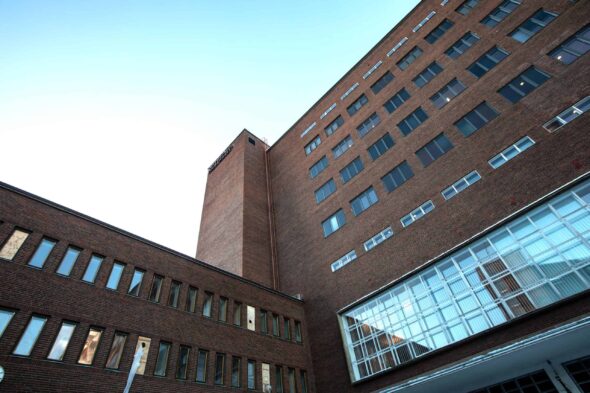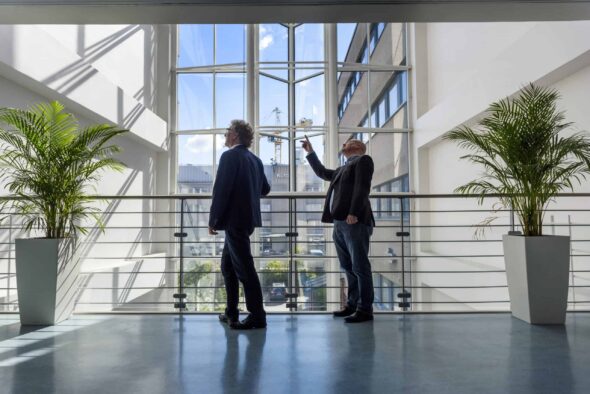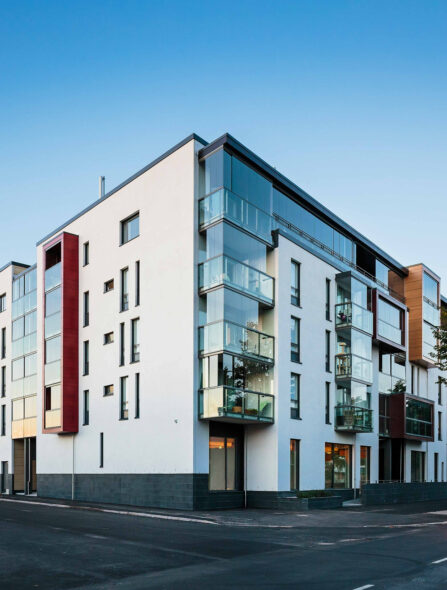Solutions
A tailored fit is better than an off-the-shelf product.
Energy-efficient building technology is the best of many worlds. We tailor the optimal solution for each building.
Technology is not an end in itself for us. It is a means to an end. That's why we never automatically recommend a particular device or technology without first looking at the property. We always choose the solution that best suits the site and the client's objectives.
Perhaps the most important energy technology of our time, it conjures clean heat from underground and even from frosty air.
Heat pumps collect energy from the air, soil or water, the most typical source being solar radiation energy stored in the environment. Heat pumps use electricity, heat exchangers, compressors and refrigerants to produce thermal energy, which, depending on the technology, is 2-4 times the amount of electricity needed by the pumps. The above mentioned coefficient of performance (COP) reveals the energy efficiency of a heat pump.
The best thing about heat pumps is their superior energy efficiency: when one dose of electricity is fed to the pump, it provides between two and four units of heat to the property, depending on the technology and conditions. It is this efficiency gain that makes heat pumps so competitive.
Heat pumps can also make use of waste heat streams, such as exhaust air from buildings and waste heat from industrial processes. The available heat sources vary and can be combined in different ways.
There are more than one million installed heat pumps in Finland, the most common of which is the simple and inexpensive air source heat pump (ILP). Ground source heat pumps (MLP), exhaust air source heat pumps (PILP) and air-to-water heat pumps (IVLP) are used to heat large properties.
Increasingly, energy wells drilled for geothermal heat are also being used for cooling. Combining heating and cooling typically pays off when one system is responsible for both.
How a logistics centre is heated by 50 energy wells
Is geothermal heating suitable for cities?
Not too much and not too little. Automatically controlled ventilation saves energy and makes indoor spaces comfortable and healthy.
Surprisingly often, ventilation in large buildings is not controlled as required by their use. In such cases, there is huge potential for savings in ventilation.
The ventilation modernisation project, which is part of the energy renovation, will look at the overall ventilation system of the building: the ventilation machines and their controls, the needs of the different spaces and the air volumes they require. It will then replace energy-wasting equipment, install heat recovery and refine the ventilation control with sensors. They monitor the temperature, humidity and carbon dioxide content of the rooms, among other things. Old machines that have been replaced will be inspected and the ventilation ducts cleaned.
Demand controlled ventilation(DCV) means that more air is exchanged where there is more moisture and carbon dioxide - and less where there is empty space. DCV solutions can save up to 50-70% of the electrical energy needed for fans and up to 30-40% of the energy needed for heating and cooling. At the same time, of course, care must be taken to ensure that energy savings from ventilation do not become an end in themselves.
In intelligent ventilation, carbon dioxide sensors constantly tell the system how much air to change. The amount of electricity needed to move the supply and exhaust air is exactly the same, and no more. Less warm air is blown into the sky, saving heating energy.
How modernising ventilation can save you money in the courthouse
The biggest savings from energy renovation are often achieved by recovering the heat energy captured in the exhaust air or other so-called waste energy streams. Waste heat recovery is also known as energy recycling.
The old way is to blow into the sky air that has just been warmed by expensive energy. A more sensible way is to capture the heat precisely and replace it with purchased energy. The higher the price of energy rises, the more profitable the investment in heat recovery becomes. Reducing the carbon footprint is another important driver.
Heat is often recovered by means of heat pumps. Thanks to technical progress in heat pumps, even lukewarm temperatures can be exploited profitably.
A relatively new way to use waste heat from ventilation is to inject it into geothermal wells. Regenerating the heat wells increases the efficiency of the system. At the same time, the energy is recovered for beneficial use.
Automation is the brain of a building's HVAC system. Intelligent automation helps to achieve an optimal balance between the desired conditions and energy consumption. Properly programmed and controlled, automation maintains good conditions at 10-15% lower cost than a mediocre system - anticipating changes in building use.
Responsible property owners will review the need for automation modernisation at least every ten years. When deciding to purchase a new system, it is worth taking into account the life cycle phase of the case under review, as the system has a long lifetime.
At the heart of almost all energy renovations carried out by LeaseGreen is an upgrade or large-scale modernisation of the automation system. The work starts with an assessment of the building's operational needs and system performance. The functionality, connectivity and intelligence of the equipment is checked. Adjustments are made to suit demand, for example, so that the ventilation intensity is adjusted according to the number of people inside. Conditions will improve and energy will be saved. Modernising an automation system is an investment that quickly pays for itself.
How automation saves Oriola €2.5 million
The operation of the automation system can be ensured and further improved by connecting the property to LeaseGreen's optimisation service. For example, the intelligent heating system can read the weather forecast and automatically increase the power a little before the cold front hits. When the weather cools down, the system drops the power at just the right time.
Solar panels are now being used to make carbon-neutral buildings.
Solar PV reduces energy costs for property owners and cuts daily peaks in consumption. It also reduces thermal radiation from the roof, which reduces the need for cooling. The unproductive roof area previously only used to shelter the building can be put to good use. Solar PV can also be seen as a visible message to the outside world about the responsibility of the building owner.
In Finland, capital invested in solar power typically generates returns equal to or slightly higher than the average real estate investment. If the solar electricity produced on your own roof or plot is used entirely on-site, the system can offer its owner an annual return of 6-8%. More and more property owners are looking into using their own solar electricity for cooling or charging electric cars.
A good rule of thumb for the potential production of solar electricity in Southern Finland is 0.8-0.9 megawatt-hours of electricity per year per installed kilowatt of capacity.
A photovoltaic system is technically quite simple: the direct current (DC) electricity produced by the solar panels is delivered to an inverter, which converts it into alternating current (AC) suitable for the property's grid. The system is automatically linked to the rest of the energy system in the building.
How OP-Vuokratuotto is turning its real estate portfolio carbon neutral
How does a 90% saving in lighting electricity consumption sound? With LED technology, it's possible - and with improved light output.
Modern LED lighting produces the same amount of light output with up to 90% less energy consumption than older light sources. The lifetime of LEDs is significantly longer than conventional solutions, which also means lower maintenance and servicing costs.
The energy efficiency of LEDs is generally worth using to improve the lighting conditions in a property. LEDs are easy to orientate and typically take less than a microsecond to light up. Building users who have received new, efficient lighting are usually surprised by the impact of the increased light output on the comfort of their working environment. Good lighting also improves safety at work.
The price of LED technology has fallen so sharply in recent years that there is no longer any need to delay replacing luminaires for financial reasons. Payback periods are very short, typically between 2 and 6 years.
Solutions
Energy-efficient building technology is the best of many worlds. We tailor the optimal solution for each building.

Competences
With our team's wide-ranging expertise, we can ensure that your buildings operate intelligently and optimally as a whole. The biggest benefit for property owners comes from the holistic approach and the fact that the selected technological pieces work well together.

Technology
We make new innovations available to customers when they have provided sufficiently strong evidence of technical viability and commercial viability.
